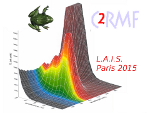N. KIJEK*, A. CHRUŚCIŃSKA
Institute of Physics, Faculty of Physics, Astronomy and Informatics,
Nicolaus Copernicus University, Grudziadzka 5, 87-100 Torun, *natalia@fizyka.umk.pl
Ceramics – pottery and bricks were one of the first objects of the thermoluminescence (TL) dating over fifty years ago. Recently, the OSL method, next to the TL method is more frequently applied in the ceramics dating [Guibert et al]. The SAR protocol, which is used in dating, was developed for geological sediments. The parameters of OSL measurements, like the temperature, the optimal stimulation time, and the manner of bleaching the signal after OSL regenerated measurements were established. Although in both methods, TL and OSL, quartz is applied, it is commonly known that the luminescent properties of quartz annealed during the pottery production in high temperature differ from the properties of quartz originating from sediments [Kijek el al.]. Therefore, some caution should be maintained in using the same protocol for sediment and ceramics dating. In the standard dating procedure, the OSL signal is read out at 125oC. In order to examine its influence on the dating results, the measurements of the De were carried out for three temperature T OSL during readout of the OSL signal in SAR protocol: 25, 70 and 125oC. Before a proper OSL measurement the preheat test was applied, in order to choose the optimal temperature for each sample. Besides the observation of the dependence of De on the temperature, the repeatability of the results (a recycling test) and the quality of bleaching the OSL signal after a regeneration dose have been monitored. For each OSL measurement temperature, the recovery test was carried out. The investigations were carried out for quartz originating from medieval bricks. The age was determined for the total of 12 samples which were collected in 2010-2013. In the quartz collected from the ceramics, the value of De is strongly dependent on the temperature of the OSL measurements. The greatest changes appears above 90oC. The obtained results of the dependence of De on the temperature of the OSL measurements (Tab. 1.) were used to determine the age of the sample for each temperature of the OSL investigations. For lower temperatures of the OSL measurements the errors of the De measurements, and also the errors determining the age, are generally lower. The comparison of the age assigned to various temperatures allows to conclude that the results for lower temperatures make it possible to obtain better correlation in groups of the samples which represent specified stage of building investigated object. The obtained dating results are actually consistent with the historical knowledge, but also allow to put forward a thesis concerning unknown fate of the church. It turned out that the samples originating from the lower part of the foundations of the church are older than the remaining part of the building, which shows that before the currently existing church there had existed an earlier brick construction at the same place and the brick from its demolition are the foundations of today's temple.
Tab. 1. The results of the dependence of De on the temperature of the OSL measurements.
Guibert, P., Bailiff, I. K., Blain, S., Gueli, A. M., Martini, M., Sibilia, E., Stella, G., Troja, S. O. (2009). Luminescence dating of architectural ceramics from an early medieval abbey: The St Philbert Intercomparison (Loire Atlantique, France) Radiat. Meas. 44(5-6), 488-493.
Kijek N., Chruścińśka A., Przegietka K. R. (2013). On the dependence of Equivalent Dose on temperature of OSL measurements for sediment quartz grains and its implication in dating practice, Radiat. Meas. 56, 252-256.
- Poster

 PDF version
PDF version

